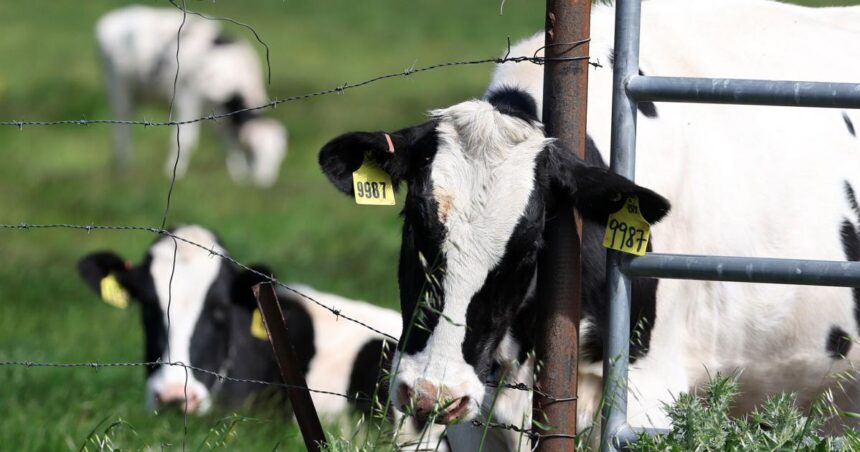Public health officials are concerned about bird flu, which has been detected in three dairy farmworkers — two in Michigan and one in Texas — as well as in cattle in a dozen states.
The farmworkers’ symptoms were mild, and researchers have not found that the H5N1 virus, also known as bird flu, can spread from person to person. The federal Centers for Disease Control and Prevention says there is little risk to the general public. However, flu viruses evolve, and H5N1 could mutate and gain the ability to infect people more easily.
“The reason public health authorities are and should be on high alert is because this is a potential high-consequence pathogen,” said Meghan Davis, an epidemiologist and microbiologist at Johns Hopkins University.
That’s why state officials are so focused on testing and surveillance of dairy workers. But they are encountering significant challenges.
People are also reading…
Cows graze in a field at a dairy farm on April 26 in Petaluma, California. Federal officials have advised dairy farms to monitor for bird flu in cattle and humans, but testing remains largely voluntary.
H5N1 is deadly to domestic poultry and can wipe out entire flocks in a matter of days, the U.S. Department of Agriculture says. As a result, the poultry industry has responded vigorously to the threat, culling entire flocks when they detect even one infected bird. But H5N1 is milder in cows, and the response on dairy farms has been less aggressive.
The CDC and USDA have advised dairy farms to monitor for the virus in cattle and humans, but testing remains voluntary, except for herds moving across state lines.
FDA testing shows half of all raw milk samples from four states in the US tested positive for bird flu.
In addition, dairy farms are often in remote rural areas, and workers have little access to transportation and no sick leave. As a result, it’s difficult for them to travel to health care providers for testing and treatment. Many dairy workers, who are mostly immigrants, speak Indigenous languages like Nahuatl or K’iche, according to the National Center for Farmworker Health, a nonprofit that offers support and training for centers that focus on the health of farmworkers.
Dr. Amesh Adalja, an infectious disease physician and scholar at the Johns Hopkins Center for Health Security, emphasized that the current bird flu strain isn’t a pandemic threat to humans. That’s why, he said, this is the perfect time to get the right testing and surveillance measures in place.
“If you can’t get it right with something that’s as forgiving as this virus has been, in terms of its inefficiency in infecting humans, it really doesn’t bode well for when the stakes are higher,” Adalja said.
So far, cases of the virus have been documented among domestic livestock in Colorado, Idaho, Iowa, Kansas, Michigan, Minnesota, New Mexico, North Carolina, Ohio, South Dakota, Texas and Wyoming, according to the USDA. Last month, federal officials announced grants to farms to offset the cost of milk loss from sick cows. Four states — Kansas, Nebraska, New Mexico and Texas — are launching voluntary pilot programs to test for the virus in dairy farms’ bulk milk tanks.
In Michigan, where the virus has been detected in 25 herds, Tim Boring, director of the state Department of Agriculture and Rural Development, said efforts are focused on trying to help farmers recoup losses and agree to testing. Last month, the agency announced it would use a combination of federal and state money to give as much as $28,000 to up to 20 affected farms.
The state also launched a study to find out if there are antibodies in people exposed to sick cows, aiming to determine if there have been any asymptomatic infections.
Dr. Natasha Bagdasarian, Michigan’s chief medical executive, said the state is working with community health clinics and local health departments to reach farmworkers.
The CDC and state of Michigan are partnering to study the blood of farm workers to better understand how bird flu is spreading.
Dairy farmworkers, who are often immigrants, can’t afford to miss a day of work, and can be reluctant to reach out to request testing or say they feel sick, advocates say.
“This is a population of people that is just vastly underserviced when it comes to both outreach and trust established with state and federal agencies,” said Elizabeth Strater, strategic campaigns director at United Farm Workers, a labor union. “This is a group of workers that are some of the poorest workers in the United States.”
Immigrants make up 51% of daily labor at dairy farms, and farms that employ immigrants produce 79% of the nation’s milk supply, according to the National Milk Producers Federation.
Amy Liebman of the Migrant Clinicians Network, an education and outreach group of experts in migrant health, said testing should be administered on the farms rather than in clinics.
But it hasn’t been easy getting farm owners to agree to that.
Coordination among state or local agricultural and health departments is key to tracking viral spread. A lack of coordination and monitoring can be contributing to underreporting cases.
“I think it is definitely more widespread than is currently reported,” said Dr. Shira Doron, chief infection control officer at Tufts Medicine. “The barriers between the agencies are really hampering our efforts right now.”
The CDC’s latest figures show that at least 53 people have been tested in the cattle outbreak, with a majority of those in Michigan. Strater says that’s not enough.
“That’s abysmal,” she said. “Our method of testing is so passive. They’re relying on workers reporting to medical clinics; these are workers that are not going to be taking themselves for medical treatment unless they’re experiencing something life-threatening.”
The CDC says there’s no evidence of humans can easily infect each other with bird flu and the risk to the general public remains low right now. (Scripps News)





